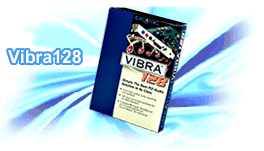
Packaged along with the Creative Vision
multimedia kit is the Creative Vibra 128 sound card. No, it is not a 128-bit
card (something similar to the confusion caused with AWE64) but rather the 128
in the title indicates the number of supported voices in the sound card.
Creative is among one of the world leaders when it comes to the manufacture of
sound cards. Not only are they among the largest manufacturers but are also
popular hot sellers.
Creative's product line extends from the basic
sound card for basic audio applications to the hare-core gaming market where
added realism through sound is a must. This of course, is where most of the
consumers are and hence, a larger share of the market. Creative does design
their own audio chipsets as well as hosting others by manufacturers such as
Ensoniq. Their Vibra 128 boards provide support for Environmental Audio, the
same as that of their Soundblaster Live! series of sound cards which are based
upon their ever popular EMU 10K1 chip.
Specifications
- 16-bit CD quality
playback
- 48-KHz sampling rate
- 128-voice wave-table synthesizer
- 16
MIDI channels, 128 GM & GS compatible
- 2MB, 4MB and 8MB wave-table
sample sets included
- PCI bus-mastering capabilities to stream audio from
the card to the host memory without any need for onboard RAM
- Support for
DirectSound, DirectSound3D and Environmental Audio in 2-speaker mode
- Sound
Blaster PCI compatible
The Creative Vibra 128 is targeted to the cost-conscious consumer looking for decent
audio playback quality which is no doubt why it is included with the
Vision Multimedia kit. It is somewhat similar to the Sound Blaster 128 without support for 4
speakers and does not include a TV Tuner In or a Rear Speaker out (for obvious
reasons).
This sound card was setup pretty much problem-free. Just
plug in the card, install the drivers and you are ready to go! As there
is no benchmark which can test sound quality, I went ahead and put it
up against your good old AC97 audio codec and give my personal opinions
about this. We all know that AC97 is your on-board sound audio and does prove for
a cost-effective audio solution, but quality-wise, is it as good as your normal plug-in audio expansion
card?
Before we answer that, here is
my system which I connected the components to. As discerning audio quality can
really be a pain sometimes, it certainly helps it by connecting PC sound to a
relatively better system than your regular multimedia speakers.
Sound
check equipment
- Carver HR-742 Sonic Holography Receiver
- Mirage
M-790 Bi-polar audiophile loudspeakers
- Mirage M-290 bookshelf speakers
-
NAD 502 CD Player
After
connecting my PC up to this system the first thing I sampled was audio from an
AC97 codec. After giving it a very long listen, I
began to reaffirm my belief that most things integrated usually lack in quality. Through this
test system, one can hear every detail with the utmost clarity. That would include "artifacts"
in audio playback. And the AC97 was full of these "artifacts". Listening to a
few MP3s through AC97 made evident the slight shrilly noise accompanied with every
played back note especially through the tweeters. Even while playing Unreal Tournament and Quake3, the sound
of deep bass sounded as though a few pieces of loose gravel was rattling through the
speakers.
Initially, I thought something
was wrong with the speakers until I connected the Vibra 128. Sound quality went through
a much needed improvement and gameplay became a lot more pleasurable. The environmental audio aspect
of the card did add a couple of esoteric highlights though it was not
as evident in the Vibra 128 due to its lack of 4-speaker support.
When playing back CDs through the Vibra 128, the sound was flattened out a bit compared
to the NAD 502 CD Player. The bass wasn't as tight and the highs weren't so
sharp.
The lack of
the warm mid-range frequencies was pretty obvious as well. Maybe I am judging
the Vibra 128 on parameters which were not supposed to be tested against as this
sound card is not aimed at the higher-end of the spectrum. But never less when
purchasing a sound card, one should know which one provides better quality
playback through any medium. Distortion was not a problem as the Vibra 128's
signal passed on to the receiver is alot cleaner than its AC97 counterpart. As
long as you are no hardcore audio enthusiast, this sound card will not envoke
any criticism from its end-users.
Aside from sound quality one of the
important aspects, especially towards performance hungry hardcore gamers, is the
amount of system resources a sound card will use. Too much dependance on the CPU
will definitely be the cause of lower frame rates. You wouldn't want to be in
Quake3 Arena just about to win the match when...BOOM!... frame rates drop to an
extreme low causing you to hesitate and avoid dodging a rocket aimed straight
towards you. So I took of liberty of running the Ziff - Davis Audio Winbench 99
to test the amount of CPU utilization used on the Vibra 128 and the AC97 audio
codec.
